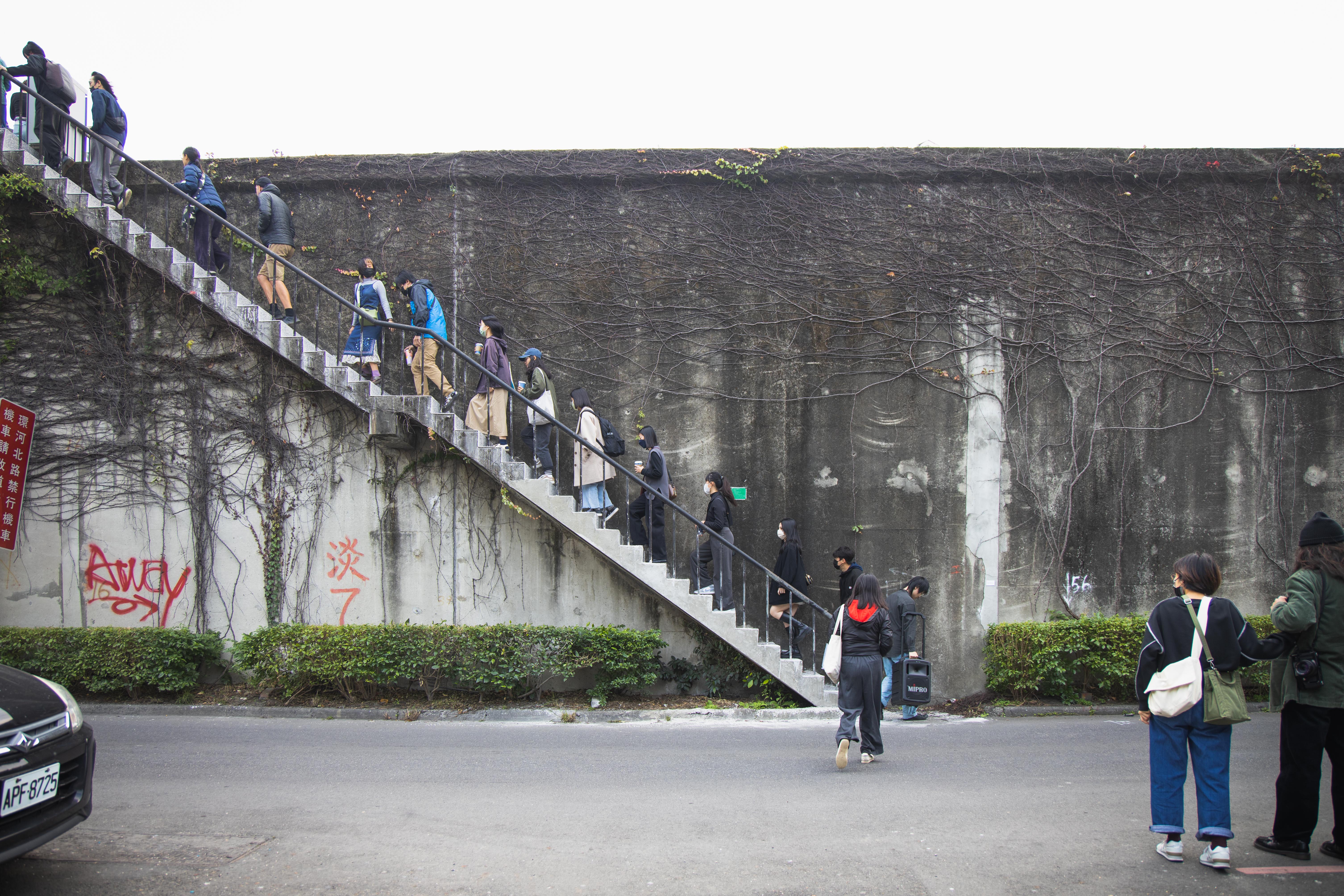一種軌跡:不易發現與不被看見
A Track:hard to be found,
and hard to be seen
鋁線
Alumunum wire
Alumunum wire
總長度約75公尺
The length is approximately 75 meters
The length is approximately 75 meters
2023
記得兩年前有次在去MoCA看展的路上,途經延平北路停等紅燈,向右看見斗大的綠色招牌寫著卡卡藝術和一串電話號碼,還有滿滿字塊的世界名言帆布,仔細讀起來才發現是偏向心靈雞湯的個人備忘錄,接著映入眼簾的是佇立在路面邊緣的自由女神像,當時心中就只有一種很突兀的感覺,想著怎會有如此特別的空間組合出現在這片環境中。
很神奇的是這樣突兀的感覺,居然會在兩年後這堂課程中再次在我腦海裡,並以思考展覽場地的狀態顯現出來。後來也才知道,原來這個地方叫社子,除了有為防範氾濫而建的堤防外,還有土地公和治吟婆,以及更多未被淹沒的人與故事。
發展作品階段,首先是理解堤防上植被的特性,包括外觀、色澤、生長與密度等要素,同時間也投入理解堤防搭建歷史的來由。選定鋁線作為創作材料的原因,除了色澤與植物氣根的外貌十分相似外,也想運用材質富有彈性的特色做出氣根仿生的樣態。在高達6公尺的堤防上創作,所花費的時間遠多於在平地上,過程中嘗試也幾個不同的造型來顯現,像是做成如同鳥巢般的造型,抑或是改變鋁線的密度來表現。在這段現地製作的時間中,我所遇到的困難比較在於如何跳脫「貫徹概念」後的自我懷疑中,懷疑在我的確做出一個非常不易被發現的作品,但如果品作品難以被發現與看見,是否還能被稱之為作品?還是只是一個融合於環境的造型呢?
對我而言,在這件作品中不易發現與不被看見是兩個連動的要素,也就是人會因不易發現,而不被發現,透過這次所創作的《一種軌跡:不易發現與不被看見》試著回應社子一帶的環境,將古銅色的鋁線融入原有的地錦(景)氣根之中,作為整體環境導引的路徑,穿梭於生態與人工之間、恬靜與吵雜之間、高低與落差之間、不易發現與不被看見之間。
展覽開幕那一天,我發現這種不易發現與不被看見的狀態會展現於觀眾觀看「作品」本身的預期思考中,我提供作品牌與作品於這面堤防的提示,但多數的觀眾會以身體的本能直接上樓梯直至頂端,這樣的結果對我而言似乎點到了作品核心,難以發現與看見的軌跡就存在觀展的過程與時間之中,但我也同時在思考作品造型的尺度,以及這件作品發生的原因。當觀眾在爬樓梯的時候,其實有個很明確的目標,我們就是要把運用我們的肢體前進到高處,那個目的性是很明確的,因此在達成這個目標的過程不容易受到「既定背景」的影響,再來可能在於我們很可能本來就容易忽略細微的事物(特別是當他們外貌很相似的時候)。特別的是,當我今天稱他們是作品的存在時,彷彿我就賦予了一個新的意義和詮釋,當我向觀眾說明作品在這面堤防時,觀眾也可能因我的提醒而特別留意作品將會出現在何處,我覺得這樣作品的找尋與找尋過程的遺漏,也是這件作品好玩的地方。
目前為止,我還是會想到我第一次帶著鋁線越過堤防到另一側發現路面裂縫的感覺,那很像一種發現新大陸的興奮感,驅使我毫不猶豫地將軌跡持續延伸下去,我想這就是在現地製作中人與環境互相交流能產生獨有的意外。帶有人工感的堤防與盤根錯節的氣根,對應著兩端完全不同的空間面貌,也隱喻著社子的前世與今生。

作品手稿 Work Script
作品製作 Work in progress

《長島》展覽開幕日 So Long ! Island Exhibition Opening Day





Two years ago, I was on my way to see an exhibition at MoCA Taipei. I passed by Yanping North Road and waited for a red light, and I saw a green signboard with KaKa Art and a series of phone numbers. There are words of world famous quotes on the canvas of. I found that it was more like a personal memo, and then I saw the Statue of Liberty standing on the edge of the road.A very strange feeling came up to me due to the combinations that are in this environment.
It's amazing that such a sudden feeling will appear in my mind again two years later, when we are in the state of thinking about the exhibition site. It was only later that I found out that this place was called Shezi. In addition to the embankment built to prevent flooding, there were also Land God Tudigong and Land Goddess Zhiyinpo, as well as more people and stories that were not submerged.
In the stage of developing works, the first thing is to figure out the characteristics of the vegetation on the embankment, including appearance, color, growth and density. At the same time, I need the history of embankment construction. The reason for choosing aluminum wire as the material for my work is not only that the color is very similar to the appearance of aerial roots, but also to use the elastic characteristics to create a bionic appearance of aerial roots. It takes much more time to create on a 6-meter-high embankment than on flat ground. I have tried several different shapes, such as making it like a bird's nest, or changing the density of the aluminum wires. During the on-site production, the difficulty I encountered was more in how to get rid of the self-doubt after "carrying out the concept". The doubt I only have is that I have made a work that is very difficult to be discovered, but if the work is difficult to be discovered Can discovering and seeing be called a work? Or is it just a shape that blends into the environment?
For me, in this work, being difficult to be seen and to be found are two interlocking elements, that is, people do not see things because the things are not easy to be found. "A Track:Hard to be found, and hard to be seen" tries to respond to the environment of the Shezi area, integrating the bronze-colored aluminum wires into the original air root. As the path of the overall environment, they shuttle between ecology and man-made, tranquility and bustle. They stand between height and descent , and be between hard to be seen and hard to be found.
On the opening of the exhibition, I found that the state of hard-to-find and invisible will be displayed in the audience's anticipatory thinking when watching the work. The track that is difficult to find and see exists in the process of walking in an exhibition. When the audience is climbing on the stairs, there is actually a very clear destination that they want to get to a higher place. The purpose is not so easy to be affected by the established background. The effect may be that we are likely to overlook subtle things (especially when they look similar.) When I call them a work, it seems that I have given a new meaning and interpretation to it. When I explain to the audience that the work is on this embankment, the audience may also pay special attention to the work because of my reminder. I think the search for such a work and the omission of the search process are also the fun of it.
So far, I was thinking of the first time I took the aluminum wires across the embankment. I climb to the other side and found the crack in the road. It was the excitement of discovering a new world that drove me to extend the track without hesitation. I think this is the unique accident that can be produced by the interaction between people and the environment in on-site production. The embankment with an artificial sense and the intertwined air roots correspond to the completely different spatial appearances at both ends, and it also metaphorize the past and the present of Shezi.